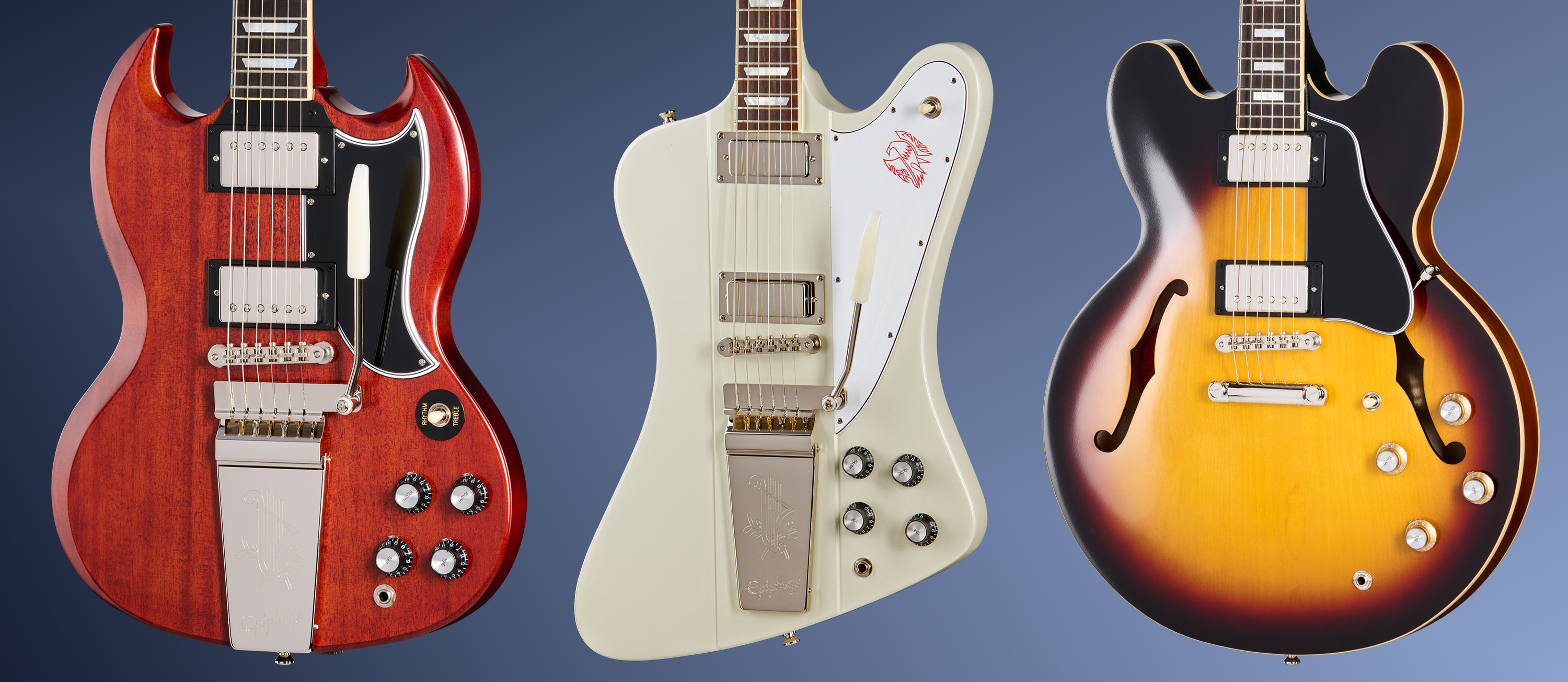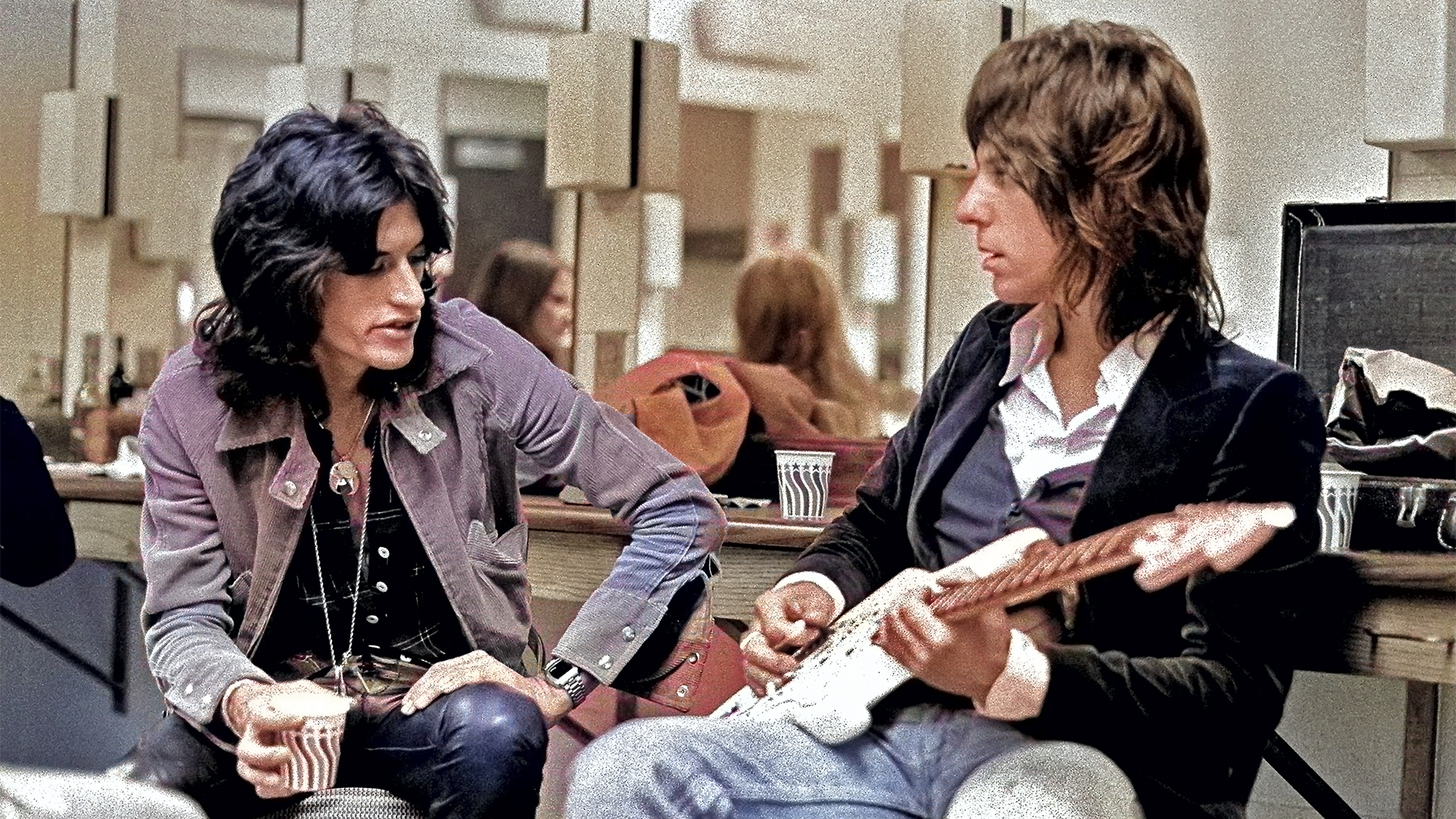GuitarPlayer Verdict
This latest batch from Epiphone's Inspired by Gibson Custom Series features some pluses (rosewood fingerboards versus the Indian Laurel) and minuses (slightly less-stringent adherence to period-correct materials, weights and grades of woods). But the end result is greater attention to vintage-correct details and many of the same parts you'll find on American-made Gibsons, making these guitars a solid choice for those who are on a budget or looking for a stage-ready guitar that sounds and performs great
Pros
- +
ES-335: Well-built and good-sounding with some upmarket components
- +
SG Standard: An impressive take on the golden-age vintage SG Standard
- +
Firebird V: An accessible price, with more vintage cred than many Gibson versions
Cons
- -
ES-335: Some forward tilt in the neck pickup’s mounting position; lacks the sonic breadth of a vintage ES or Gibson Custom version
- -
SG Standard: High-E string slot cut a little too close to the edge of the nut
- -
Firebird V: A few slightly sharp fret ends
You can trust Guitar Player.
Previous releases in Epiphone’s Inspire by Gibson Custom Series have received broadly favorable responses from reviewers and players alike, with some bordering on ecstatic declarations of “Gibson quality at Epi prices.”
So it’s no surprise the maker is capitalizing on the success by expanding the range. Newly unveiled are the 1959 Les Paul Standard, 1960 Les Paul Special Double Cut Reissue, 1962 ES-335 Reissue, 1964 SG Standard Reissue with Maestro Vibrola, and 1963 Firebird V with Maestro Vibrola Reissue in Polaris White, the latter three of which I got in-house for review.
As with the previous IBGC electric guitars, each represents a close collaboration between the Chinese-made Epiphone guitars and the luthiers of Gibson’s Nashville-based Custom department. The two-fold goal therein includes greater attention to vintage-correct details and the use of many of the same parts that feature on American-made Gibson guitars.
Each of these guitars, for example, has the same USA-made Custombucker or Firebird pickups used on their Custom counterparts, as well as CTS potentiometers, Switchcraft jacks and switches, Black Beauty paper-in-oil or Mallory tone caps, and other components you’ll find on top-flight, USA-made guitars.
The two-fold goal includes greater attention to vintage-correct details and the use of many of the same parts that feature on American-made Gibson guitars.
— Dave Hunter
Unsurprisingly, the IBGC guitars have to achieve some cost-savings somewhere. This is found in a slightly less-stringent adherence to period-correct materials, weights and grades of woods used, and overall fit and finish. That said, without dropping any major spoiler here, I’ve also found all of these elements to still be very satisfactory — certainly “good for the price” — and they’re mentioned here to fully round out the quality that can be expected in the $1,149 to $1,699 within which these three guitars reside.
Some of the austerity measures include the use of polyurethane finishes rather than nitrocellulose lacquer, bridge-mounting bushings rather than vintage posts-into-wood, and somewhat less precise metals and plastics formulations in some parts.
Upgraded in the new batch, however, are the rosewood fingerboards versus the Indian Laurel used previously, and the look and feel of all three guitars are outwardly impressive upon lifting from their respective included IBGC hardshell cases. All three were tested through a Marshall JTM45 reissue head and 2x12 cab, a tweed Deluxe-style 1x12 combo, and a Fractal FM9 modeler into Sennheiser headphones.
All the latest guitar news, interviews, lessons, reviews, deals and more, direct to your inbox!
1962 ES-335 Reissue
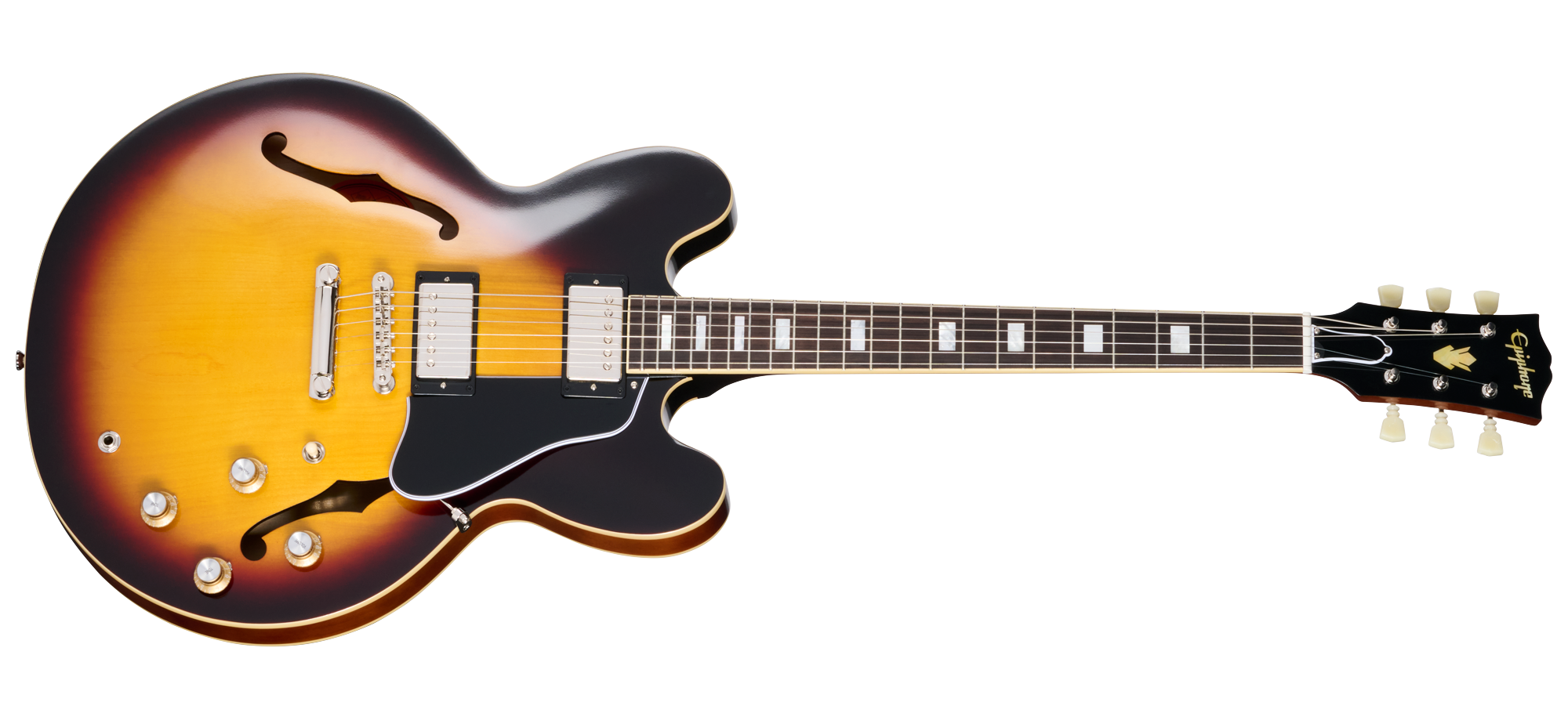
The ES-335 likely needs no introduction, and this Epiphone IBGC 1962 ES-335 Reissue remains true to form in shape and overall construction. The semihollow body features laminated five-ply maple/poplar front, back and sides, with a solid maple center block and spruce bracing. It’s a little deeper than most vintage ’62s I’ve played, but it checks most of the right boxes.
The neck is the traditional one-piece mahogany construction, with a bound rosewood fingerboard, small-block inlays and the proper Gibson-shaped “open-book” headstock that the entire series wears. It’s carved to a SlimTaper profile, Gibson’s long-standing interpretation of a ’60s neck. While it has never been my favorite shape, and doesn’t feel quite like most genuine early ’60s examples I’ve played, this one is enhanced by nicely rounded (a.k.a. “rolled”) edges where the neck transitions across the fingerboard, which notably aids playing comfort. The 22 medium-jumbo frets are smooth and well dressed, if not as jeweler-precise as those of the high-end Gibson equivalents.
My test guitar arrived with the Vintage Burst stain, with Sixties Cherry is also available, and finished in a Vintage Gloss that seeks to replicate the lower sheen of a slightly aged guitar, without going full-on satin. The pickups are American-made Alnico III Custombuckers wired through CTS potentiometers with Black Beauty paper-in-oil tone caps, all presenting essentially the same signal path you’d find in a Gibson Custom ES-335.
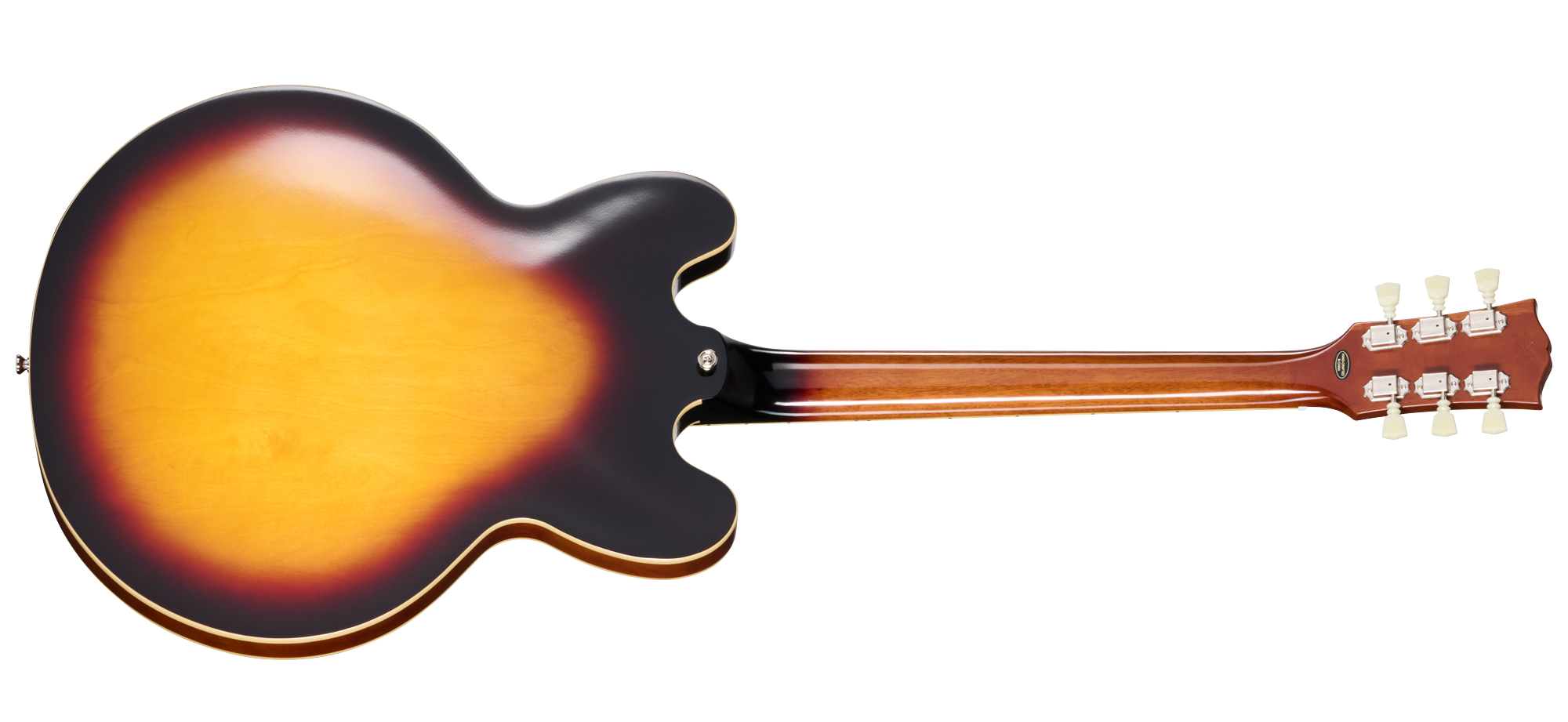
One minor note involves some forward tilt in the neck-position pickup, which couldn’t be cured with a nudge or height adjustment. This is something that can be caused by the way the arched top of the body forms a steep decline into the neck joint and is often remedied in original ES models by mounting the pickup ring the reverse of the usual in this position, with the higher side up against the end of the fingerboard.
The ES-335 Reissue captured a hefty dose of that classic Gibson ES warmth-with-bite, and ably displayed the broad sonic versatility for which the design is famous.
— Dave Hunter
Plugged in, the Epiphone IBGC 1962 ES-335 Reissue captured a hefty dose of that classic Gibson ES warmth-with-bite, and ably displayed the broad sonic versatility for which the design is famous. There’s an edgy, granular texture within the humbucker-fueled tone of an ES-335 versus, for example, a Les Paul with the same electronics, and this Epi has it in abundance. Filtered through these Custombuckers, the guitar’s mid-budget-semi-acoustic construction delivers a little more depth and harmonic dimension, and the full package combines to make this a very capable ES at this price.
This foundation translates well to classic ES-335 character through both clean and overdriven tones, which contributes to the detail and crispness that enables a good semi-acoustic to nail everything from jazz to pop to country, or the thick yet articulate chewiness that makes for such and expressive blues or classic-rock instrument into some overdrive. If the Epiphone IBGC 1962 ES-335 doesn’t have quite the openness or sonic breadth of a good vintage ES, or to some extent a Gibson Custom version, it’s still a lot of semi-acoustic guitar for the price and worth checking out if you’re in the market.
1964 SG Standard with Maestro Vibrola
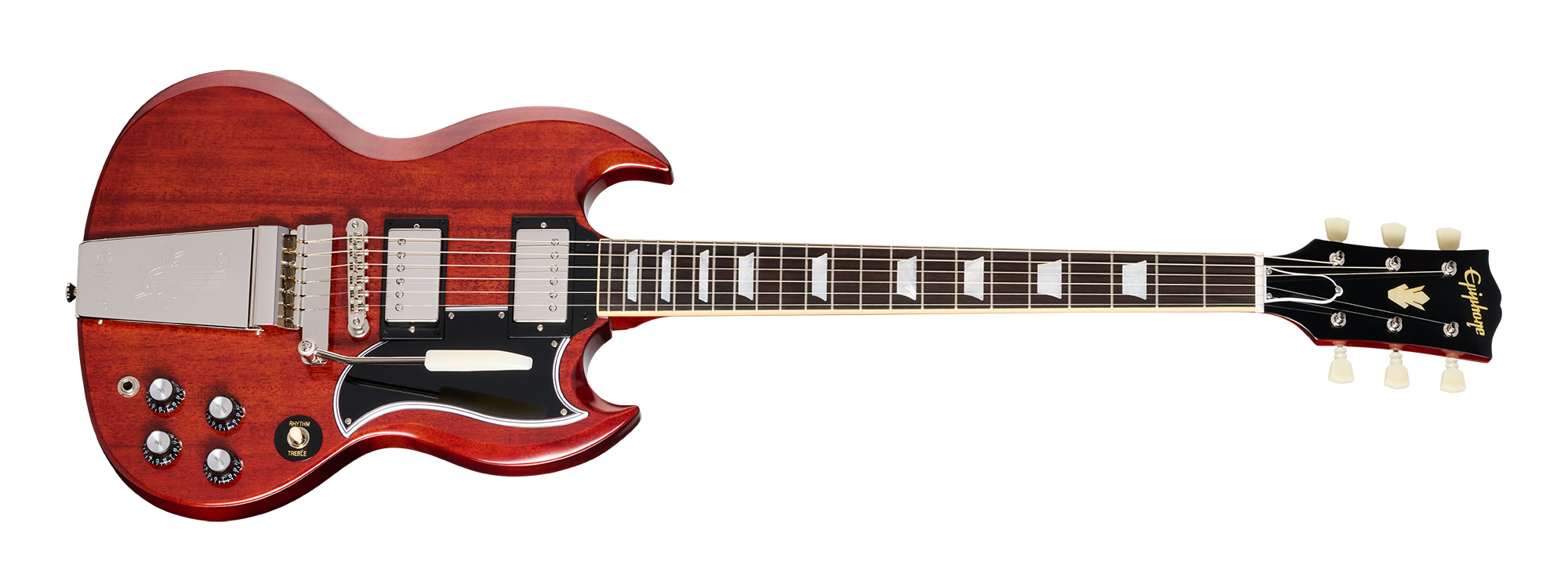
Of the myriad renditions of the SG Standard that Gibson and Epiphone haveproduced over the years, and Epiphone in their wake, the very first SG of all might be the most iconic, and most desired. Which is to say, the first SG proper, after the Les Paul Standard name used on the original, equipped with a clunky sideways vibrato, became simply the SG of 1963-’64, with simpler, more functional Maestro vibrato (or Vibrola, as officially called here).
After that, part-way through ’65, the SG and other Gibsons took on the slimmer 1 9/16" nut width, hardware moved from nickel-plated to chromed, pickups and other details changed… and that was that. It was precisely that model the Who's Pete Townshend favored onstage from 1968 into the early 1970s.
As such, the Epiphone IBGC 1964 SG Standard with Maestro Vibrola captures a major chunk of first-gen SG magic at an accessible price. The Epi IBGC version retains all the key aspects of the SG form, including the slim two-piece mahogany body with asymmetrical double-cut “horns,” glued-in mahogany neck with 22nd-fret neck/body joint for an easy reach right to the final medium-jumbo fret, bound rosewood fingerboard with the trapezoidal inlays the model ported over from its days as the Les Paul Standard, and the smaller pickguard that signaled the first few years of the design.
The Cherry Red finish in Vintage Gloss strikes a good midway point between the brighter cherry these guitars were born with and the mid-brown they often faded to. Like the ES-335 above, the SG Standard’s neck is carved to Gibson’s SlimTaper profile but with rolled fingerboard edges. It likewise carries the Alnico III Custombuckers that are standard for all PAF-pickup-sized guitars in the range, plus the CTS pots and Black Beauty paper-in-oil tone caps.

Also akin to all three guitars here, it has the Tune-o-matic bridge that’s a little wider in saddle-travel-width from back to front than the vintage-standard ABR-1, and which is also anchored to the body with stud bushings rather than the posts themselves, one of a handful of concessions to the offshore build process. It’s also a tad heavier than I would ideally like an SG to be.
Fit and finish are generally good, with just a few mild snags on the fret ends, but I’m somewhat more concerned by the high-E slot being cut a little too close to the edge of the nut, leading you to pull that string off the edge of the ’board occasionally while playing.
The Epiphone IBGC 1964 SG Standard with Maestro Vibrola captures a major chunk of first-gen SG magic at an accessible price.
— Dave Hunter
Otherwise, the construction is sleek and confidently “Gibson-like” throughout, and you’d likely not think twice about the pedigree without a good look at that headstock logo. The Maestro Vibrola functions smoothly, too, with decent return-to-pitch from this setup if you don’t overdo it (any tuning snags are likely down to the saddle and nut slots rather than the vibrato spring itself); and it certainly looks cool even if you never touch it.
Amped up, the IBGC 1964 SG Standard Reissue easily dials in the thick-but-cutting tones that have made the SG archetype so popular through the years. The thin body and high neck joint lend a brightness and snappiness that has always helped to define the SG voice.
But there’s also a weightier “thunk” in the mids than the ES delivers, for example, and good warmth and thickness that never folds over into muddiness through heavy overdrive. As ever with a competent SG, it’s kind of a no-brainer of a rock guitar, but lends itself well to gentler and more nuanced styles, too.
1963 Firebird V with Maestro Vibrola Reissue
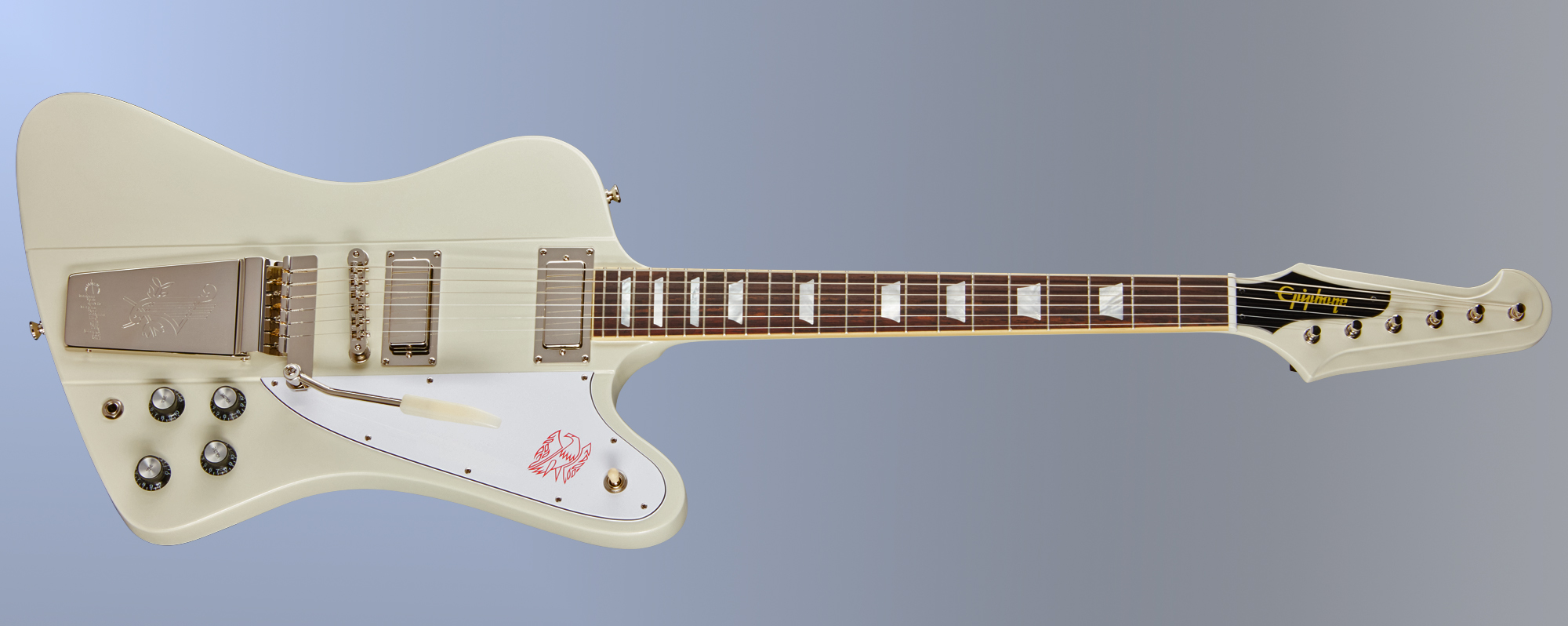
This one is more of a color-and-features update than a fully new IBGC model, considering the 1963 Firebird V was available in Vintage Sunburst, Frost Blue, Ember Red,and Cherry Red as of last year. But it also features a genuine rosewood fingerboard now in place of the Indian Laurel of the recent past, and it’s such a cool and relatively authentic recreation of the reverse-body Firebird at this price that it’s worth a quick look. Plus, who doesn’t dig a reverse-body ’Bird in Polaris White finish?
Sketched out by automotive designer Ray Dietrich as Gibson’s shot across the bow at Fender’s offset-waist Jazzmaster and Jaguar — yet with “reversed” lines and proportions to avoid any appearance of direct copying — the Firebird of 1963–’64 was Gibson’s most complexly constructed solidbody guitar yet. The key to this is the through-body neck construction, made from a central core of nine plies of mahogany and walnut that extends from the tip of the headstock through the full length of the body, with slightly thinner mahogany “wings” attached to complete the proportions.
Epiphone bills the neck end of this as being carved to “a SlimTaper rounded C profile,” although here on the Firebird it’s significantly deeper at around .845 inches, compared to .820 inches, or slightly under, on the ES-335 and SG Standard.
Six-in-line banjo tuners avoid spoiling the lines of the reversed raptor headstock. The rest of the hardware and electronics follow the nod of the 1964 SG Standard above, other than in the Alnico V Firebird Mini Humbuckers, which I’ve found to be a major step up from the overly hot ceramic-magnet versions Gibson was using for several years up until the late 2010s or so.

One notable alteration from the original vintage setup involves the more traditional alignment of each pickup’s tone knob being placed behind its Volume knob as with Les Pauls, SGs, ES models and others, rather than below its respective volume knob as on the ’63–’64 Firebirds. With that said, this is likely a wise move intended to preempt any user confusion.
The IBGC Firebird V played well right out of the case, despite a smidge of fret-end sharpness, and even better after I dropped the bridge down slightly for a faster action. Once plugged in — much as was my impression of the Sunburst example a year ago.— I was flabbergasted by the hefty chunk of authentic reverse-body Firebird tone and feel available from this guitar.
The IBGC FIrebird V goes a long, long way down the road — further than many Firebirds Gibson itself made in the ’80s, ’90s, and ’00s — and negates the need to spend any more to achieve “that sound” if you’re not a purist.
— Dave Hunter
Sure, the pickups are bright and cutting, and the bridge position can even be a little strident (taken care of with the Tone wound down to seven, which is most habitual Firebird players’ default setting anyway), but they’re far less so — and also richer and more dynamic — than the high-output ceramic units used for a few decades, and in fact match vintage ’60s Firebird Mini Humbuckers surprisingly well.
And hey, “bright and cutting” is what the ’Bird is all about. Through clean or edge-of-breakup amp settings it approximates Telecaster tones surprisingly well, and truly sizzles through heavier gain, with good articulation and expressive sustain aided by the through-body neck construction.
Having owned and played vintage reverse-body Firebirds and Gibson Custom renditions alike, maybe this IBGC model isn’t 100 percent there, to be fair, but it goes a long, long way down the road — further than many Firebirds Gibson itself made in the ’80s, ’90s, and ’00s — and arguably negates the need to spend any more to achieve “that sound,” if you’re not a purist, or simply not willing to spend several times the money.
Conclusion
As we’ve seen with previous IBGC releases, the collaboration between Gibson Custom and Epiphone continues to a great working relationship between the strengths of the two brands, while establishing a very solid waypoint between Epiphone affordability and Gibson Custom quality in the process. Each of these guitars meets, and arguably exceeds, the overall quality and tone of some of the more budget-friendly, fully American–made Gibson models we’ve seen in the past (the Studio, Special and Faded lines come to mind), and the inclusion of the same pickups used on many Custom guitars pushed them over the top.
I’ve never been a fan of the SlimTaper profile myself. I find it a tad generic and flat-backed, and would prefer to see more authentic, rounded-C ’60s shapes used. But it’s still with us because plenty of players apparently dig it, so that shouldn’t stop anyone from checking out the latest great offerings from Epiphone’s IBGC series.
Inspired by Gibson Custom 1962 ES-335
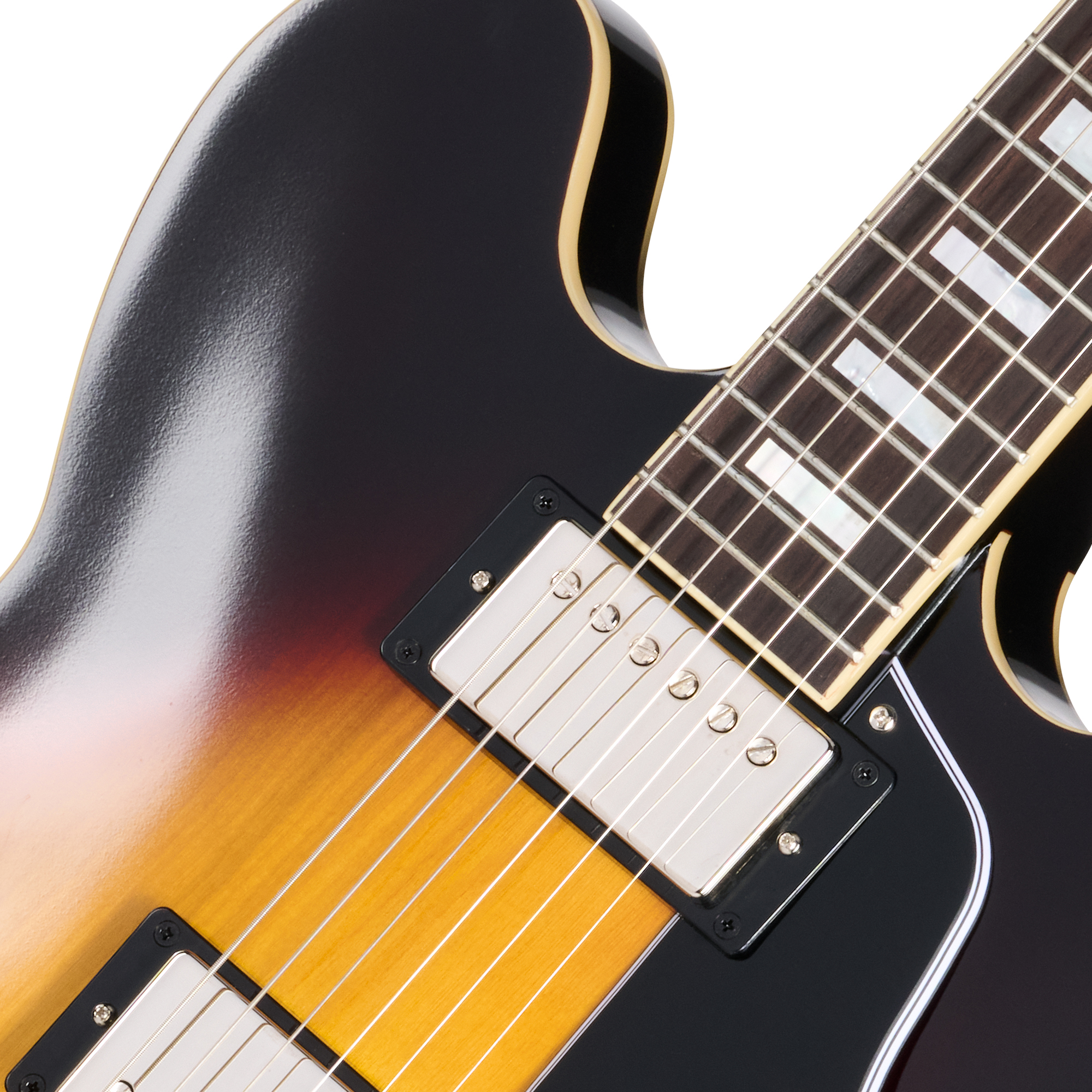
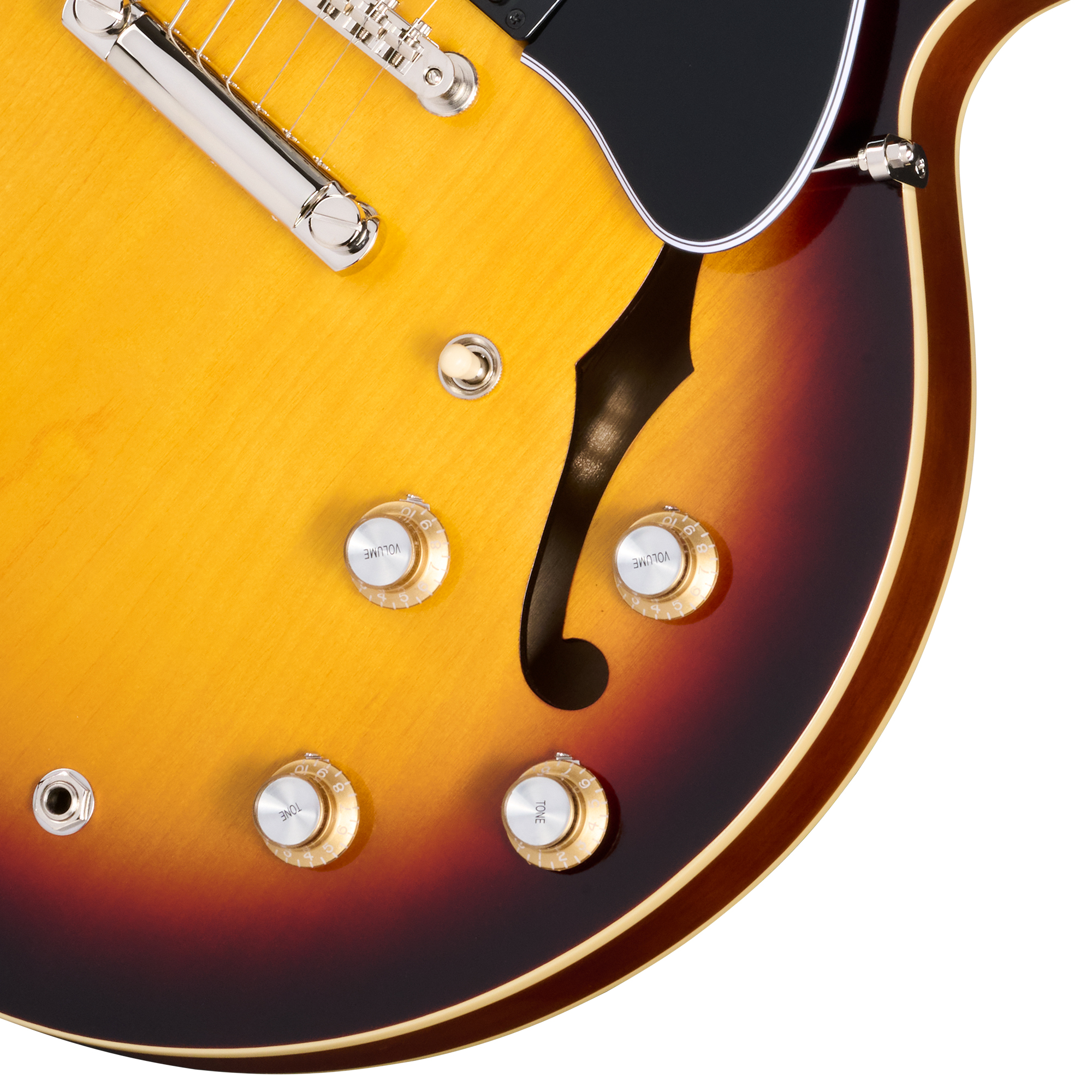


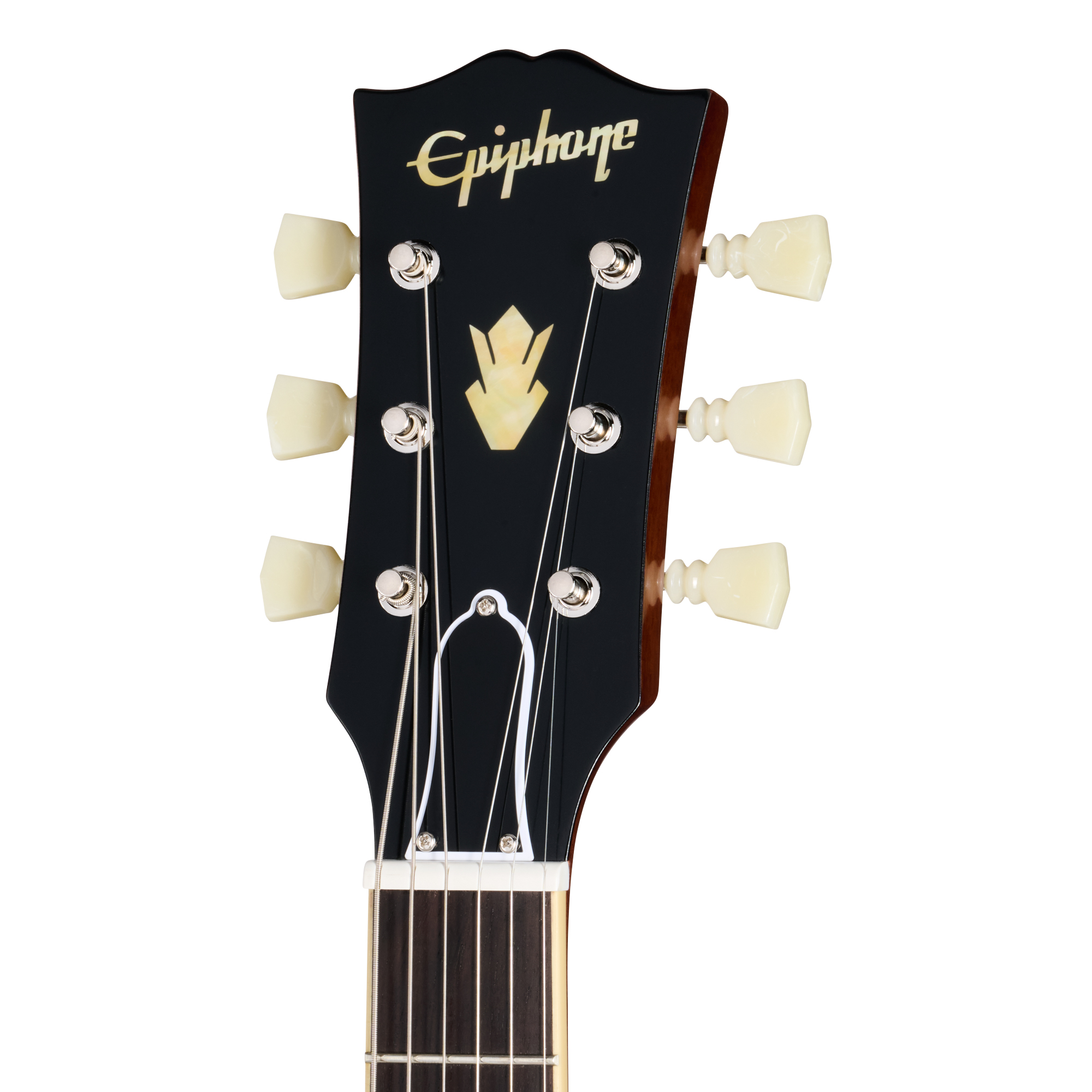
SPECIFICATIONS
CONTACT epiphone.com
PRICE $1,149 street
NUT Graph Tech, 1.692" wide
NECK One-piece mahogany, 24.75" scale length, ’60s SlimTaper profile
FRETBOARD Rosewood, 12" radius
FRETS 22 medium-jumbo
TUNERS Epiphone Deluxe double-ring
BODY Semi-acoustic laminated 5-ply maple/poplar with solid maple center block
BRIDGE ABR-1 tune-o-matic and stopbar tailpiece
PICKUPS Two Gibson Custombuckers
CONTROLS Two volume controls, two tone controls with Black Beauty paper-in-oil capacitors, three-way selector switch
FACTORY STRINGS Epiphone .010-.046
WEIGHT 8.7 lbs
BUILT (country of origin) China
KUDOS A well-built and good-sounding ES-335 for the money, graced with some upmarket components.
CONCERNS Some forward tilt in the neck pickup’s mounting position. Lacks the sonic breadth of a vintage ES or Gibson Custom version
Inspired by Gibson Custom 1964 SG Standard with Maestro Vibrola
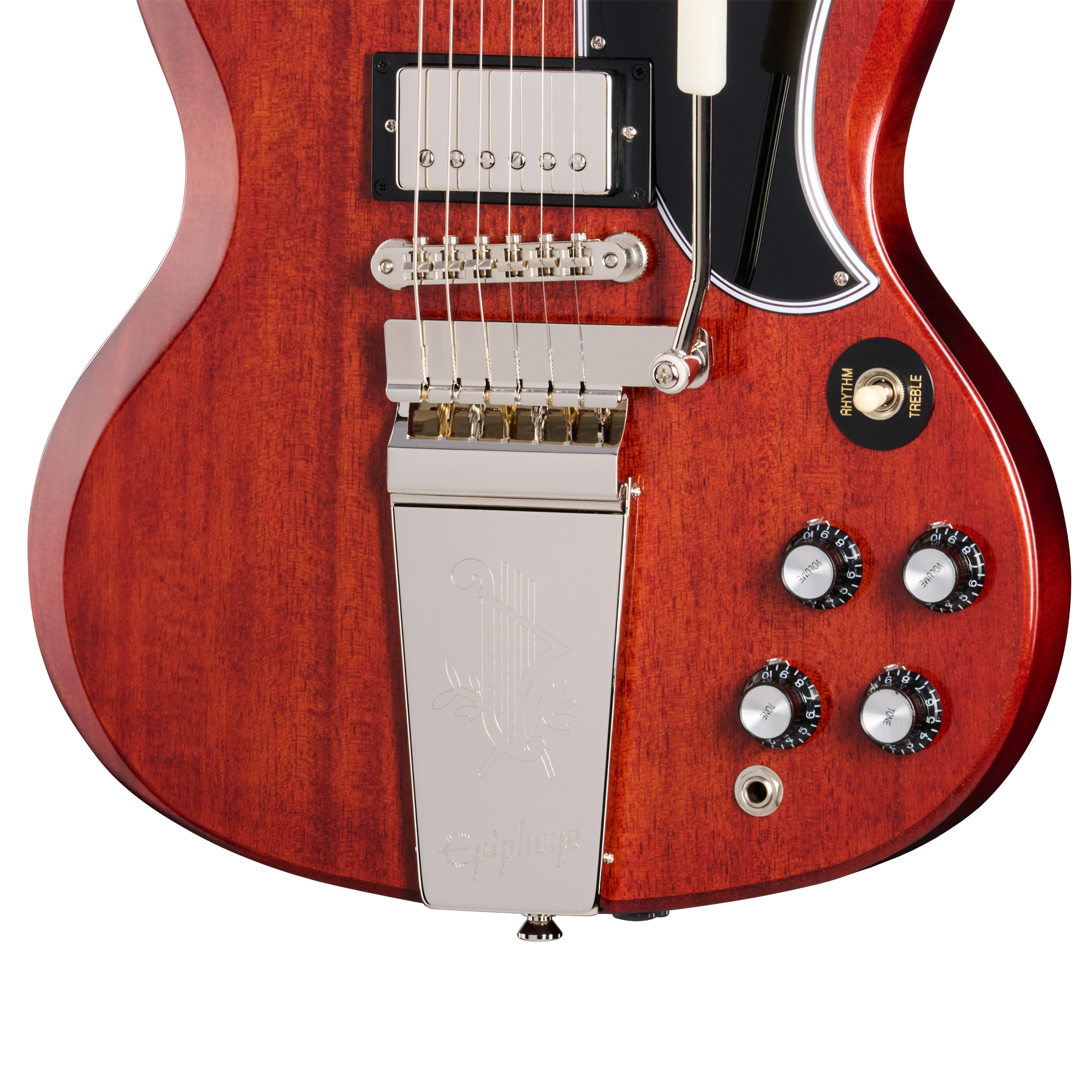



SPECIFICATIONS
CONTACT epiphone.com
PRICE $1,299 street
NUT Graph Tech, 1.692" wide
NECK Mahogany, 24.75" scale length, ’60s SlimTaper profile
FRETBOARD Indian laurel, 12" radius
FRETS 22 medium-jumbo
TUNERS Epiphone Deluxe double-ring
BODY Solid mahogany with 9-ply mahogany/walnut core
BRIDGE Tune-o-matic bridge with Maestro vibrola tailpiece
PICKUPS Two Gibson Custombuckers
CONTROLS Two volume controls, two tone controls with Black Beauty paper-in-oil capacitors, three-way selector switch
FACTORY STRINGS Epiphone .010-.046
WEIGHT 8.8 lbs
BUILT (country of origin) China
KUDOS An impressive take on the golden-age vintage SG Standard for the price
CONCERNS High-E string slot cut a little too close to the edge of the nut
Inspired by Gibson Custom 1963 Firebird V
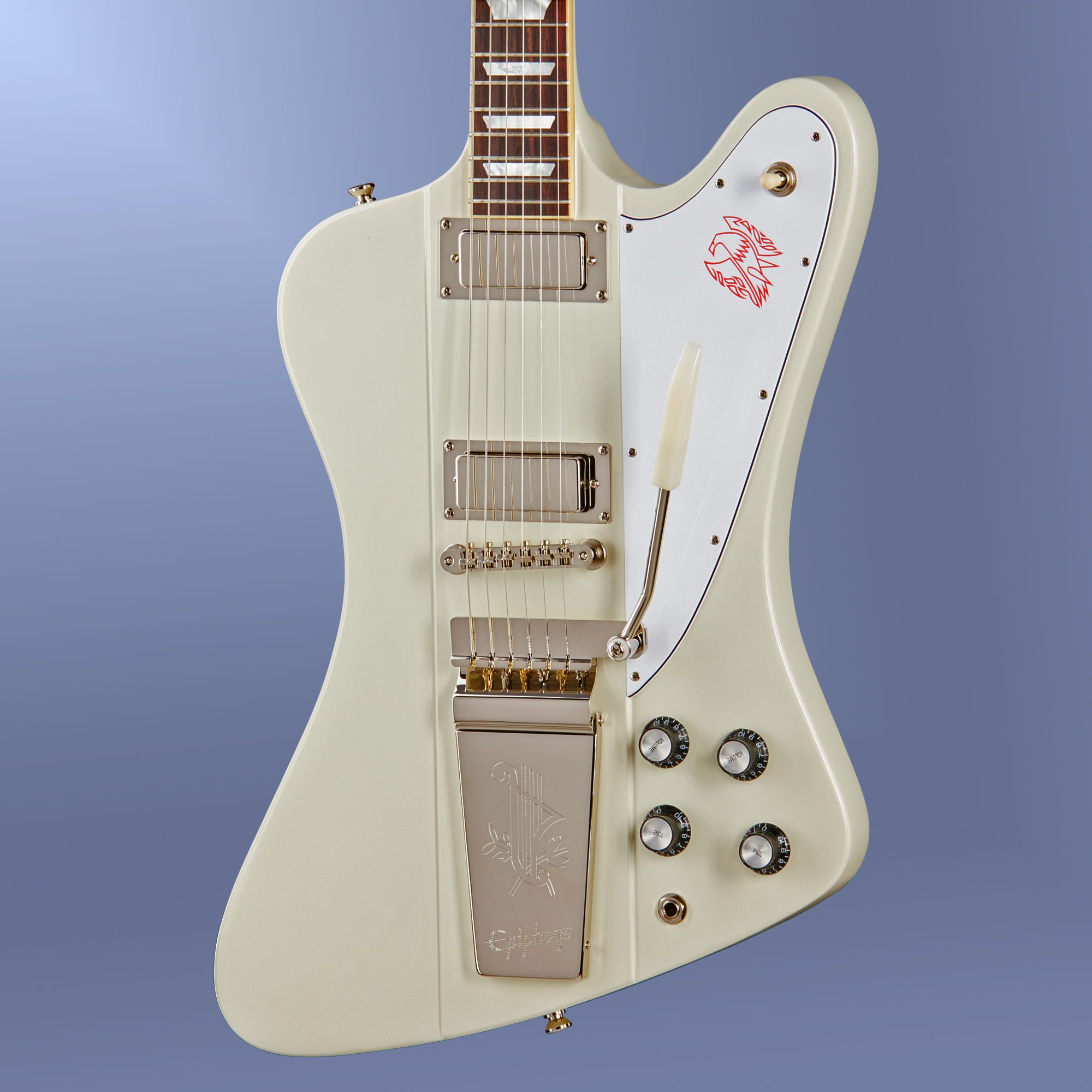
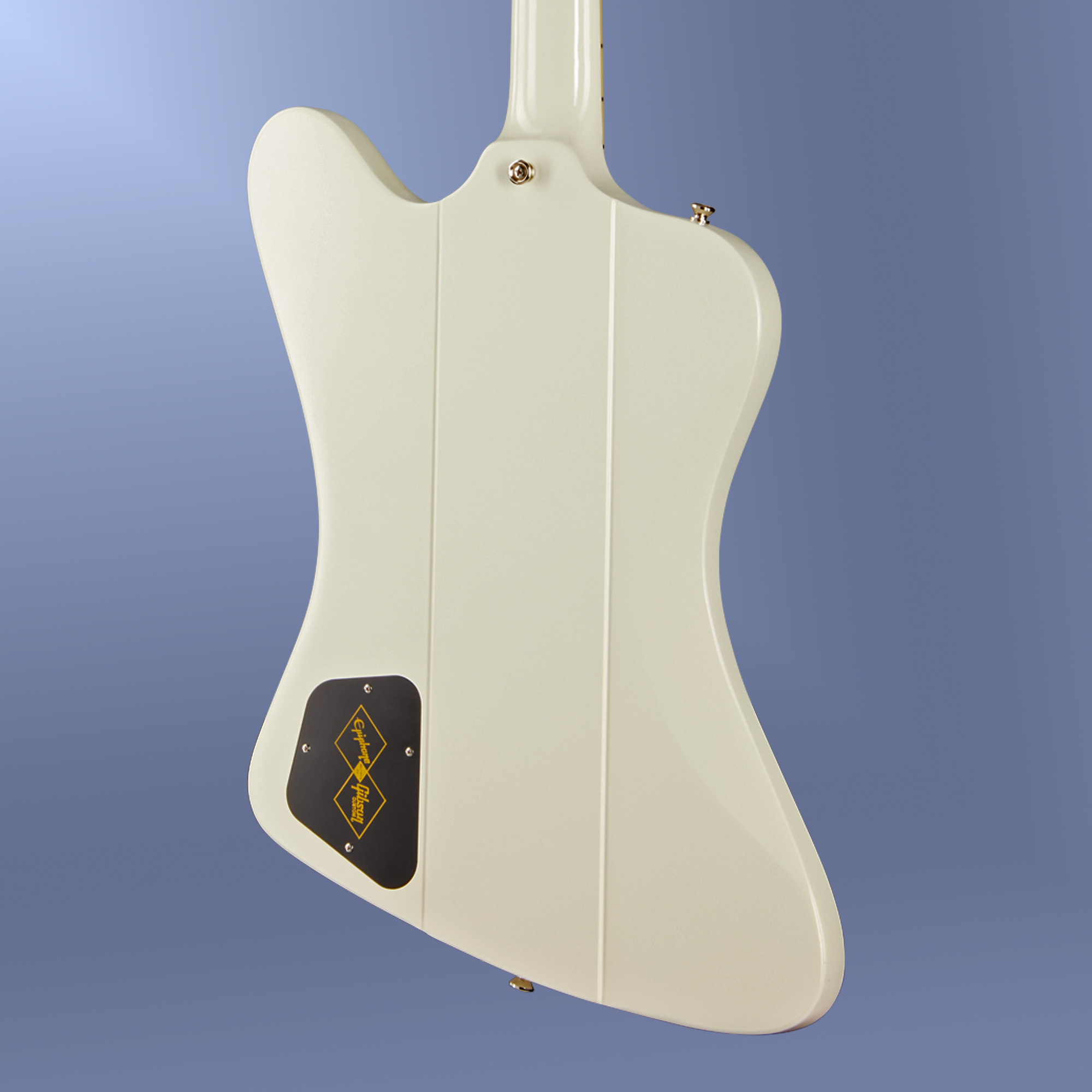


SPECIFICATIONS
CONTACT epiphone.com
PRICE $1,699 street
NUT Graph Tech, 1.692" wide
NECK 9-ply mahogany/walnut, 24.75" scale length, ’60s SlimTaper profile
FRETBOARD Rosewood, 12" radius
FRETS 22 medium-jumbo
TUNERS Kluson “Banjo Style” Planetary
BODY Solid mahogany with 9-ply mahogany/walnut core
BRIDGE Tune-o-matic bridge with Maestro vibrola tailpiece
PICKUPS Two Gibson Firebird mini-humbuckers with Alnico V magnets
CONTROLS Two volume controls, two tone controls with Mallory tone caps, three-way selector switch
FACTORY STRINGS Epiphone .010-.046
WEIGHT 9.1 lbs
BUILT (country of origin) China
KUDOS A great take on the reverse-body Firebird V at an accessible price, with more vintage cred than many Gibson versions offered for a few decades
CONCERNS A few slightly sharp fret ends
Dave Hunter is a writer and consulting editor for Guitar Player magazine. His prolific output as author includes Fender 75 Years, The Guitar Amp Handbook, The British Amp Invasion, Ultimate Star Guitars, Guitar Effects Pedals, The Guitar Pickup Handbook, The Fender Telecaster and several other titles. Hunter is a former editor of The Guitar Magazine (UK), and a contributor to Vintage Guitar, Premier Guitar, The Connoisseur and other publications. A contributing essayist to the United States Library of Congress National Recording Preservation Board’s Permanent Archive, he lives in Kittery, ME, with his wife and their two children and fronts the bands A Different Engine and The Stereo Field.
